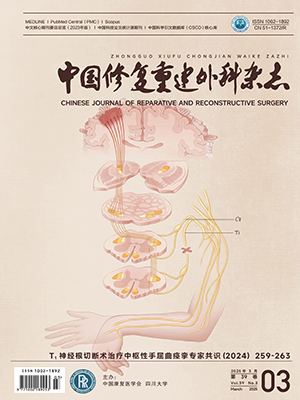【Abstract】 Objective To compare the effect of PLGA and collagen sponge combined with rhBMP-2 on repairing of
articular cartilage defect in rabbits respectively. Methods PLGA and collagen sponge were made into cyl inders which were 4 mm in diameter and 3 mm in thickness, and compounded with rhBMP-2 (0.5 mg). Defect 4 mm in diameter were made in both of femoral condyles of 24 two-month-old New Zealand white rabbits. The defects in right 18 knees were treated with PLGA/rhBMP-2 composites (experimental group 1), and the left 18 knees were treated with collagen sponge/rhBMP-2 composites (experimental group 2), the other 12 knees were left untreated as control group. At 4, 12 and 24 weeks after operation, the animals were sacrificed and the newly formed tissues were observed macroscopically and microscopically, graded histologically and analyzed statistically. Results From the results of macroscopical and microscopical observation, in the experimental group 1, the defects were filled with smooth and translucent cartilage; while in the experimental group 2, the white translucent tissues did not
fill the defects completely; and in the two experimental groups, the new cartilage tissues demarcated from the surrounding cartilage,chondrocytes distributed uniformly but without direction; a l ittle fibrous tissue formed in the control group 4 weeks postoperatively. In the experimental group 1, the defects were filled completely with white, smooth and translucent cartilage tissue without clear l imit with normal cartilage; while in the experimental group 2, white translucent tissues formed, the boundary still could be recognized; in the two experimental groups, the thickness was similar to that of the normal cartilage; the cells paralleled to articular surface in the surface layer, but in the deep layer, the cells distributed confusedly, the staining of matrix was positive but a l ittle weak; subchondral bone and tide mark recovered and the new tissue finely incorporated with normal cartilage;however, in the control group, there was a l ittle of discontinuous fibrous tissue, chondrocytes maldistributed in the border and
the bottom of the defects 12 weeks postoperatively. In the experimental group 1, white translucent cartilage tissues formed, the boundary disappeared; in the experimental group 2, the color and the qual ity of new cartilage were similar to those of 12 weeks; in the two experimental groups, the thickness of the new cartilage, which appeared smooth, was similar to that of the normal cartilage, the chondrocytes arranged uniformly but confusedly; the staining of matrix was positive and subchondral bone and tide mark recovered, the new tissue finely incorporated with normal cartilage; in the control group, a layer of discontinuous fibrous tissue formed in the bottom of the defects 24 weeks postoperatively. Results of histological grade showed that there were significant
difference between experimental group (1 and 2) and control group at any time point (P lt; 0.01); the scores of 12 weeks and 24 weeks in experimental group 1 and 2 had a significant difference compared with that of 4 weeks (P lt; 0.01), there was no significant difference between 12 weeks and 24 weeks (P gt; 0.05), and there were no significant difference between the two experimental groups at the same time point (P gt; 0.05). Conclusion Both PLGA and collagen sponge as a carrier compounded with rhBMP-2 can repair articular cartilage defects.
Citation: CUI Yuming,WU Ji,HU Yunyu. THE COMPARATIVE STUDY ON THE REPARATIVE EFFECT OF PLGA AND COLLAGEN SPONGE COMBINEDWITH BMP ON THE ARTICULAR CARTILAGE DEFECT OF RABBITS/. Chinese Journal of Reparative and Reconstructive Surgery, 2008, 22(2): 148-152. doi: Copy
Copyright © the editorial department of Chinese Journal of Reparative and Reconstructive Surgery of West China Medical Publisher. All rights reserved




